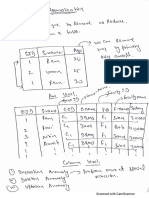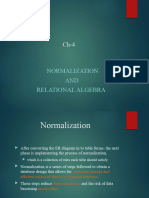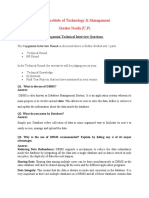0% found this document useful (0 votes)
112 views12 pagesNormalization Is A Method For Organizing Data Elements in A Database Into Tables
This relation is in 1NF since it contains repeating groups (multiple items per invoice).
To convert it to 2NF, we need to remove partial dependencies. We can create two tables:
InvoiceHeader
Inv#, date, custID, Name
InvoiceLineItems
Inv#, Part#, Desc, Price, #Used, ExtPrice
This relation is now in 2NF.
To convert it to 3NF, we need to remove transitive dependencies. We can create an additional table:
Customer
custID, Name
The final tables in 3NF are:
InvoiceHeader
Inv#, date, custID
Customer
custID, Name
InvoiceLineItems
Inv
Uploaded by
Pragati ShuklaCopyright
© © All Rights Reserved
We take content rights seriously. If you suspect this is your content, claim it here.
Available Formats
Download as DOC, PDF, TXT or read online on Scribd
0% found this document useful (0 votes)
112 views12 pagesNormalization Is A Method For Organizing Data Elements in A Database Into Tables
This relation is in 1NF since it contains repeating groups (multiple items per invoice).
To convert it to 2NF, we need to remove partial dependencies. We can create two tables:
InvoiceHeader
Inv#, date, custID, Name
InvoiceLineItems
Inv#, Part#, Desc, Price, #Used, ExtPrice
This relation is now in 2NF.
To convert it to 3NF, we need to remove transitive dependencies. We can create an additional table:
Customer
custID, Name
The final tables in 3NF are:
InvoiceHeader
Inv#, date, custID
Customer
custID, Name
InvoiceLineItems
Inv
Uploaded by
Pragati ShuklaCopyright
© © All Rights Reserved
We take content rights seriously. If you suspect this is your content, claim it here.
Available Formats
Download as DOC, PDF, TXT or read online on Scribd
/ 12
























































































